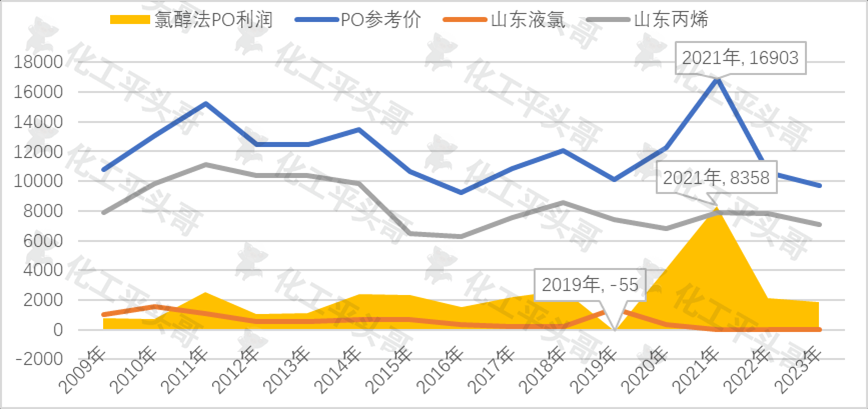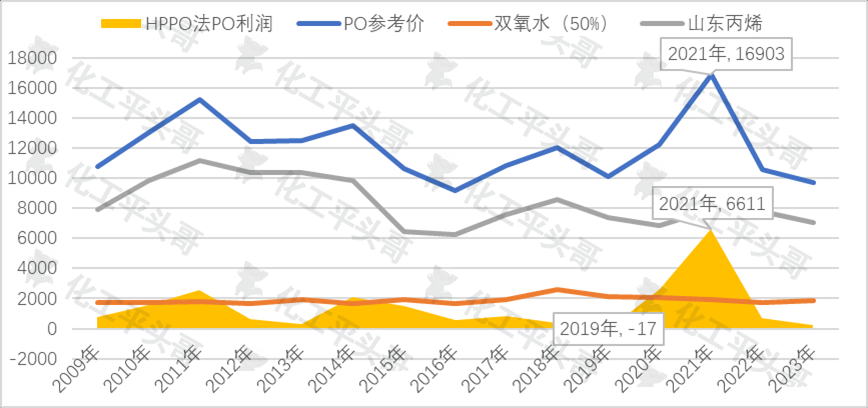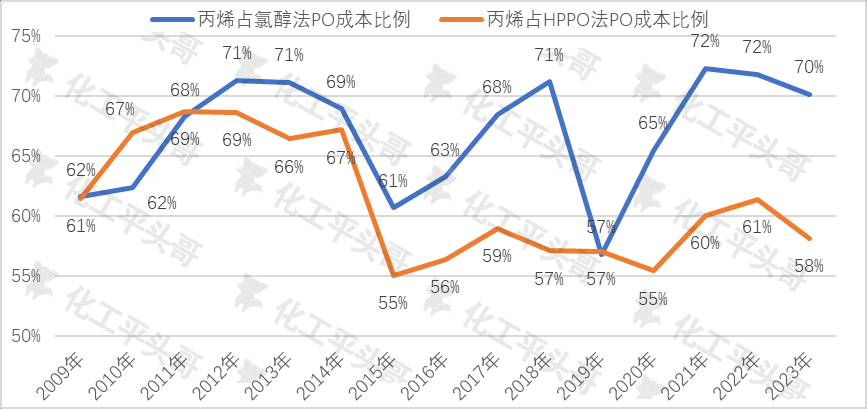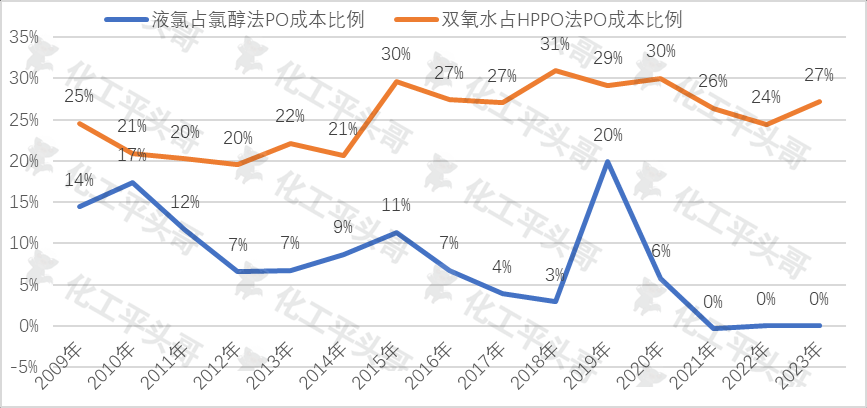Yn 'e lêste jierren hat it technologyske proses fan 'e gemyske yndustry fan Sina wichtige foarútgong makke, wat laat hat ta de diversifikaasje fan gemyske produksjemetoaden en de differinsjaasje fan konkurrinsjefermogen op 'e gemyske merk. Dit artikel giet benammen yn op 'e ferskate produksjeprosessen fan epoxypropaan.
Neffens it ûndersyk binne der strikt nommen trije produksjeprosessen foar epoxypropaan, nammentlik de chlorohydrine-metoade, de ko-oksidaasjemetoade (Halcon-metoade), en de wetterstofperokside-direkte oksidaasjemetoade (HPPO). Op it stuit binne de chlorohydrine-metoade en de HPPO-metoade de mainstream prosessen foar de produksje fan epoxypropaan.
De chlorohydrine-metoade is in metoade foar it produsearjen fan epoxypropaan mei propyleen en chloorgas as grûnstoffen troch prosessen lykas chlorohydrinaasje, ferseping en destillaasje. Dit proses hat in hege opbringst fan epoxypropaan, mar it genereart ek in grutte hoemannichte ôffalwetter en útlaatgas, wat in wichtige ynfloed hat op it miljeu.
De ko-oksidaasjemetoade is in proses foar it produsearjen fan propyleenokside mei propyleen, ethylbenzeen en soerstof as grûnstoffen. Earst reagearret ethylbenzeen mei loft om ethylbenzeenperoxide te produsearjen. Dêrnei ûndergiet ethylbenzeenperoxide in syklisaasjereaksje mei propyleen om epoxypropaan en fenylethanol te produsearjen. Dit proses hat in relatyf kompleks reaksjeproses en produseart in protte byprodukten, wêrtroch it ek negative gefolgen hat foar it miljeu.
De HPPO-metoade is in proses fan it tafoegjen fan metanol, propyleen en wetterstofperokside yn in massaferhâlding fan 4.2:1.3:1 oan in reaktor mei zeoliet titaniumsilikaatkatalysator (TS-1) foar reaksje. Dit proses kin 98% fan wetterstofperokside omsette, en de selektiviteit fan epoxypropaan kin 95% berikke. In lytse hoemannichte foar in part reagearre propyleen kin werom nei de reaktor recycled wurde foar werbrûk.
It wichtichste is dat de epoxypropaan produsearre troch dit proses op it stuit it ienige produkt is dat tastien is foar eksport yn Sina.
Wy berekkenje de priistrend fan 2009 oant mids 2023 en observearje de feroarings yn 'e produksje fan epichlorohydrine en HPPO-prosessen yn 'e ôfrûne 14 jier.
Epichlorohydrine-metoade
1.De epichlorohydrine-metoade is meastentiids rendabel. Yn 'e ôfrûne 14 jier berikte de produksjewinst fan epichlorohydrine mei de chlorohydrine-metoade it heechste punt op 8358 yuan/ton, wat yn 2021 barde. Yn 2019 wie der lykwols in lyts ferlies fan 55 yuan/ton.
2.De winstfluktuaasje fan 'e epichlorohydrine-metoade is yn oerienstimming mei de priisfluktuaasje fan epichlorohydrine. As de priis fan epoxypropaan tanimt, nimt de produksjewinst fan 'e epichlorohydrine-metoade ek ta. Dizze konsistinsje reflektearret de mienskiplike ynfloed fan feroaringen yn merkfraach en -oanbod en produktwearde op 'e prizen fan 'e twa produkten. Bygelyks, yn 2021, fanwegen de pandemy, naam it ferbrûk fan sêfte skompolyether signifikant ta, wat op syn beurt de priis fan epoxypropaan omheech dreau, wêrtroch úteinlik in histoarysk hichtepunt yn 'e winstmarge fan epichlorohydrineproduksje ûntstie.
3.De priisfluktuaasjes fan propyleen en propyleenokside litte in lange-termyn trendkonsistinsje sjen, mar yn 'e measte gefallen is der in signifikant ferskil yn 'e fluktuaasje-amplitude tusken de twa. Dit jout oan dat de prizen fan propyleen en epichlorohydrine beynfloede wurde troch ferskate faktoaren, wêrby't propyleenprizen in bysûnder wichtige ynfloed hawwe op 'e produksje fan epichlorohydrine. Fanwegen it feit dat propyleen de wichtichste grûnstof is foar de produksje fan epichlorohydrine, sille de priisfluktuaasjes in wichtige ynfloed hawwe op 'e produksjekosten fan epichlorohydrineproduksje.
Oer it algemien is de produksjewinst fan epichlorohydrine yn Sina de ôfrûne 14 jier it grutste part fan 'e ôfrûne 14 jier yn in rendabele steat west, en de winstfluktuaasjes binne yn oerienstimming mei de priisfluktuaasjes fan epichlorohydrine. Propyleenprizen binne in wichtige faktor dy't de produksjewinst fan epichlorohydrine yn Sina beynfloedet.
HPPO-metoade epoxy propaan
1.De Sineeske HPPO-metoade foar epoxypropaan is al it grutste part fan 'e tiid rendabel west, mar de winst is oer it algemien leger yn ferliking mei de chlorohydrine-metoade. Yn in tige koarte perioade hat de HPPO-metoade ferliezen meimakke yn epoxypropaan, en it winstnivo wie meastentiids signifikant leger as dat fan 'e chlorohydrine-metoade.
2.Troch de flinke tanimming fan 'e priis fan epoxypropaan yn 2021 berikte de winst fan HPPO-epoxypropaan in histoarysk hichtepunt yn 2021, mei in maksimum fan 6611 yuan/ton. Der is lykwols noch in ferskil fan hast 2000 yuan/ton tusken dit winstnivo en de chlorohydrine-metoade. Dit jout oan dat hoewol de HPPO-metoade yn bepaalde aspekten foardielen hat, de chlorohydrine-metoade noch altyd wichtige foardielen hat yn termen fan algemiene winstjouwens.
3.Derneist, troch de winst fan 'e HPPO-metoade te berekkenjen mei in priis fan 50% wetterstofperokside, waard fûn dat der gjin wichtige korrelaasje is tusken de priis fan wetterstofperokside en de priisfluktuaasjes fan propyleen en propyleenokside. Dit jout oan dat de winst fan 'e HPPO-metoade fan Sina foar epoxypropaan beheind wurdt troch de prizen fan propyleen en wetterstofperokside mei hege konsintraasje. Fanwegen de nauwe korrelaasje tusken de priisfluktuaasjes fan dizze grûnstoffen en tuskenprodukten en faktoaren lykas merkfraach en oanbod en produksjekosten, hat it in wichtige ynfloed hân op 'e produksjewinst fan epoxypropaan mei de HPPO-metoade.
De fluktuaasje yn produksjewinst fan Sina's HPPO-metoade epoxypropaan yn 'e ôfrûne 14 jier hat de skaaimerken sjen litten fan it meast rendabel te wêzen, mar mei in lege winstjouwens. Hoewol it yn bepaalde aspekten foardielen hat, moat de winstjouwens oer it algemien noch ferbettere wurde. Tagelyk wurdt de winst fan HPPO-metoade epoxypropaan sterk beynfloede troch de priisfluktuaasjes fan grûnstoffen en tuskenprodukten, benammen propyleen en wetterstofperokside mei hege konsintraasje. Dêrom moatte fabrikanten de merktrends nau kontrolearje en produksjestrategyen ridlik oanpasse om it bêste winstnivo te berikken.
De ynfloed fan 'e wichtichste grûnstoffen op har kosten ûnder twa produksjeprosessen
1.Hoewol't de winstfluktuaasjes fan 'e epichlorohydrine-metoade en de HPPO-metoade konsekwint binne, binne der wichtige ferskillen yn 'e ynfloed fan grûnstoffen op har winsten. Dit ferskil jout oan dat der ferskillen binne yn kostenbehear en winstkontrôlemooglikheden tusken dizze twa produksjeprosessen by it omgean mei fluktuaasjes yn grûnstofprizen.
2.Yn 'e chlorohydrine-metoade berikt de ferhâlding fan propyleen ta kosten in gemiddelde fan 67%, goed foar mear as de helte fan 'e tiid, en berikt in maksimum fan 72%. Dit jout oan dat yn it produksjeproses fan chlorohydrine de kosten fan propyleen de grutste ynfloed hawwe op gewicht. Dêrom hat de fluktuaasje fan propyleenpriis in direkte ynfloed op 'e kosten en winst fan epichlorohydrineproduksje mei de chlorohydrine-metoade. Dizze observaasje is yn oerienstimming mei de lange-termyn trend fan winst- en propyleenpriisfluktuaasjes yn 'e produksje fan epichlorohydrine mei de chlorohydrine-metoade dy't earder neamd is.
Yn tsjinstelling, yn 'e HPPO-metoade is de gemiddelde ynfloed fan propyleen op 'e kosten 61%, wêrby't guon de heechste ynfloed hawwe mei 68% en de leechste mei 55%. Dit jout oan dat yn it HPPO-produksjeproses, hoewol it kostenynfloedgewicht fan propyleen grut is, it net sa sterk is as de ynfloed fan 'e chlorohydrine-metoade op 'e kosten. Dit kin te tankjen wêze oan 'e wichtige ynfloed fan oare grûnstoffen lykas wetterstofperokside dy't brûkt wurdt yn it HPPO-produksjeproses op 'e kosten, wêrtroch't de ynfloed fan propyleenpriisfluktuaasjes op 'e kosten ferminderet.
3.As de priis fan propyleen mei 10% fluktuearret, sil de kostenynfloed fan 'e chlorohydrine-metoade dy fan 'e HPPO-metoade grutter wêze. Dit betsjut dat by fluktuaasjes yn propyleenprizen de kosten fan 'e chlorohydrine-metoade mear beynfloede wurde, en relatyf sjoen hat de HPPO-metoade bettere kostenbehear- en winstkontrôlemooglikheden. Dizze observaasje ûnderstreket nochris de ferskillen yn reaksje op fluktuaasjes yn grûnstofprizen tusken ferskate produksjeprosessen.
Der is konsekwinsje yn winstfluktuaasjes tusken de Sineeske chlorohydrine-metoade en de HPPO-metoade foar epoxypropaan, mar der binne ferskillen yn 'e ynfloed fan grûnstoffen op har winst. By it omgean mei fluktuaasjes yn grûnstofprizen litte de twa produksjeprosessen ferskillende kostenbehear- en winstkontrôlemooglikheden sjen. Dêrûnder is de chlorohydrine-metoade gefoeliger foar de fluktuaasje fan 'e propyleenpriis, wylst de HPPO-metoade goede risikobestindigens hat. Dizze wetten hawwe wichtige begeliedende betsjutting foar bedriuwen by it kiezen fan produksjeprosessen en it formulearjen fan produksjestrategyen.
De ynfloed fan helpmaterialen en grûnstoffen op har kosten ûnder twa produksjeprosessen
1.De ynfloed fan floeibere chloor op 'e kosten fan epichlorohydrineproduksje mei de chloorhydrinemetoade is de ôfrûne 14 jier gemiddeld mar 8% west, en kin sels beskôge wurde as hast gjin direkte kostenynfloed. Dizze observaasje jout oan dat floeibere chloor in relatyf lytse rol spilet yn it produksjeproses fan chloorhydrine, en de priisfluktuaasjes hawwe in lytse ynfloed op 'e kosten fan epichlorohydrine produsearre troch chloorhydrine.
2.De kostenynfloed fan wetterstofperokside mei hege konsintraasje op 'e HPPO-metoade fan epoxypropaan is signifikant heger as dy fan chloorgas op 'e kostenynfloed fan 'e chlorohydrine-metoade. Wetterstofperokside is in wichtige oksidant yn it HPPO-produksjeproses, en de priisfluktuaasjes hawwe in direkte ynfloed op 'e kosten fan epoxypropaan yn it HPPO-proses, allinich twadde nei propyleen. Dizze observaasje ûnderstreket de wichtige posysje fan wetterstofperokside yn it HPPO-produksjeproses.
3.As de ûndernimming syn eigen byprodukt chloorgas produseart, kin de kostenynfloed fan chloorgas op epichlorohydrineproduksje negearre wurde. Dit kin te tankjen wêze oan de relatyf lytse hoemannichte byprodukt chloorgas, dy't in relatyf beheinde ynfloed hat op 'e kosten fan epichlorohydrineproduksje mei chloorhydrine.
4.As in konsintraasje fan 75% wetterstofperokside brûkt wurdt, sil de kostenynfloed fan wetterstofperokside op 'e HPPO-metoade fan epoxypropaan mear as 30% bedrage, en de kostenynfloed sil rap bliuwe tanimmen. Dizze observaasje jout oan dat de epoxypropaan produsearre troch de HPPO-metoade net allinich beynfloede wurdt troch wichtige fluktuaasjes yn 'e grûnstof propyleen, mar ek troch wichtige fluktuaasjes yn 'e priis fan wetterstofperokside. Troch de tanimming fan 'e konsintraasje fan wetterstofperokside dy't brûkt wurdt yn it HPPO-produksjeproses nei 75%, nimme de hoemannichte en kosten fan wetterstofperokside ek neffens ta. Der binne mear merkbeynfloedzjende faktoaren, en de flechtigens fan 'e winsten sil ek tanimme, wat in gruttere ynfloed sil hawwe op 'e merkpriis.
Der is in signifikant ferskil yn 'e kostenynfloed fan helpgrûnstoffen foar de produksjeprosessen fan epichlorohydrine mei de chlorohydrinemetoade en de HPPO-metoade. De ynfloed fan floeibere chloor op 'e kosten fan epichlorohydrine produsearre mei de chlorohydrinemetoade is relatyf lyts, wylst de ynfloed fan wetterstofperokside op 'e kosten fan epichlorohydrine produsearre mei de HPPO-metoade wichtiger is. Tagelyk, as in bedriuw syn eigen byprodukt chloorgas produseart of ferskillende konsintraasjes wetterstofperokside brûkt, sil de kostenynfloed ek ferskille. Dizze wetten hawwe wichtige begeliedende betsjutting foar bedriuwen om produksjeprosessen te kiezen, produksjestrategyen te formulearjen en kostenkontrôle út te fieren.
Op basis fan aktuele gegevens en trends sille de oanhâldende projekten fan epoxypropaan yn 'e takomst de hjoeddeistige skaal oertreffe, wêrby't de measte nije projekten de HPPO-metoade en ethylbenzeen-ko-oksidaasjemetoade oannimme. Dit ferskynsel sil liede ta in tanimming fan 'e fraach nei grûnstoffen lykas propyleen en wetterstofperokside, wat in gruttere ynfloed sil hawwe op 'e kosten fan epoxypropaan en de totale kosten fan 'e yndustry.
Fanút in kostenperspektyf kinne bedriuwen mei in yntegreare yndustrieel ketenmodel it ynfloedgewicht fan grûnstoffen better kontrolearje, wêrtroch't de kosten wurde fermindere en de konkurrinsjefermogen op 'e merk ferbettere wurdt. Troch it feit dat de measte nije projekten foar epoxypropaan yn 'e takomst de HPPO-metoade sille brûke, sil de fraach nei wetterstofperokside ek tanimme, wat it gewicht fan 'e ynfloed fan wetterstofperoksidepriisfluktuaasjes op 'e kosten fan epoxypropaan sil ferheegje.
Derneist sil de fraach nei propyleen ek tanimme troch it gebrûk fan 'e ethylbenzeen-ko-oksidaasjemetoade yn nije projekten fan epoxypropaan yn 'e takomst. Dêrom sil de ynfloed fan propyleenpriisfluktuaasjes op 'e kosten fan epoxypropaan ek tanimme. Dizze faktoaren sille mear útdagings en kânsen bringe foar de epoxypropaanyndustry.
Oer it algemien sil de ûntwikkeling fan 'e epoxypropaanyndustry yn 'e takomst beynfloede wurde troch oanhâldende projekten en grûnstoffen. Foar bedriuwen dy't HPPO- en ethylbenzeen-ko-oksidaasjemetoaden brûke, moat mear omtinken jûn wurde oan kostenkontrôle en ûntwikkeling fan yndustriële ketenintegraasje. Foar leveransiers fan grûnstoffen is it needsaaklik om de stabiliteit fan 'e oanfier fan grûnstoffen te fersterkjen en de kosten te kontrolearjen om de konkurrinsjefermogen op 'e merk te ferbetterjen.
Pleatsingstiid: 8 septimber 2023








